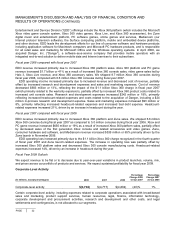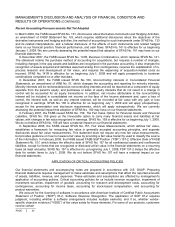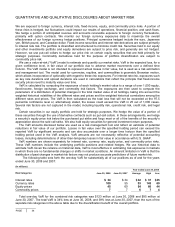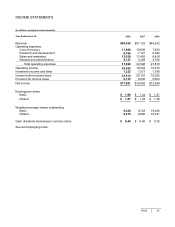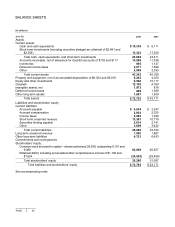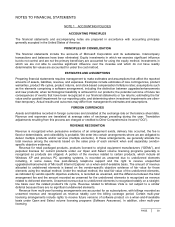Microsoft 2008 Annual Report Download - page 32
Download and view the complete annual report
Please find page 32 of the 2008 Microsoft annual report below. You can navigate through the pages in the report by either clicking on the pages listed below, or by using the keyword search tool below to find specific information within the annual report.
PAGE 31
elements of our products over a period of time. These elements include free post-delivery telephone support and
the right to receive unspecified upgrades/enhancements of Microsoft Internet Explorer on a when-and-if-available
basis. The fair value of these elements is recognized over the estimated life cycle for the Windows XP and
previous PC operating systems. For Windows Vista, there are no significant undelivered elements and
accordingly, no license revenue is deferred for Windows Vista sales. Changes to the elements in a software
arrangement, the ability to identify VSOE for those elements, the fair value of the respective elements, and
changes to a product’s estimated life cycle could materially impact the amount of earned and unearned revenue.
Judgment is also required to assess whether future releases of certain software represent new products or
upgrades and enhancements to existing products.
SFAS No. 115, Accounting for Certain Investments in Debt and Equity Securities, and Staff Accounting Bulletin
Topic 5M, Accounting for Noncurrent Marketable Equity Securities, provide guidance on determining when an
investment is other-than-temporarily impaired. Investments are reviewed quarterly for indicators of other-than-
temporary impairment. This determination requires significant judgment. In making this judgment, we employ a
systematic methodology quarterly that considers available quantitative and qualitative evidence in evaluating
potential impairment of our investments. If the cost of an investment exceeds its fair value, we evaluate, among
other factors, general market conditions, the duration and extent to which the fair value is less than cost, and our
intent and ability to hold the investment. We also consider specific adverse conditions related to the financial
health of and business outlook for the investee, including industry and sector performance, changes in
technology, operational and financing cash flow factors, and rating agency actions. Once a decline in fair value is
determined to be other-than-temporary, an impairment charge is recorded and a new cost basis in the investment
is established. If market, industry, and/or investee conditions deteriorate, we may incur future impairments.
SFAS No. 142, Goodwill and Other Intangible Assets, requires that goodwill be tested for impairment at the
reporting unit level (operating segment or one level below an operating segment) on an annual basis (July 1 for
us) and between annual tests if an event occurs or circumstances change that would more likely than not reduce
the fair value of a reporting unit below its carrying value. These events or circumstances could include a
significant change in the business climate, legal factors, operating performance indicators, competition or sale or
disposition of a significant portion of a reporting unit. Application of the goodwill impairment test requires
judgment, including the identification of reporting units, assignment of assets and liabilities to reporting units,
assignment of goodwill to reporting units, and determination of the fair value of each reporting unit. The fair value
of each reporting unit is estimated using a discounted cash flow methodology. This analysis requires significant
judgments, including estimation of future cash flows, which is dependent on internal forecasts, estimation of the
long-term rate of growth for our business, the useful life over which cash flows will occur, and determination of our
weighted average cost of capital. Changes in these estimates and assumptions could materially affect the
determination of fair value and goodwill impairment for each reporting unit. We allocate goodwill to reporting units
based on the reporting unit expected to benefit from the combination. We evaluate our reporting units on an
annual basis and, if necessary, reassign goodwill using a relative fair value allocation approach.
We account for research and development costs in accordance with applicable accounting pronouncements,
including SFAS No. 2, Accounting for Research and Development Costs, and SFAS No. 86, Accounting for the
Costs of Computer Software to be Sold, Leased, or Otherwise Marketed. SFAS No. 86 specifies that costs
incurred internally in researching and developing a computer software product should be charged to expense until
technological feasibility has been established for the product. Once technological feasibility is established, all
software costs should be capitalized until the product is available for general release to customers. Judgment is
required in determining when technological feasibility of a product is established. We have determined that
technological feasibility for our software products is reached after all high-risk development issues have been
resolved through coding and testing. Generally, this occurs shortly before the products are released to
manufacturing.
The outcomes of legal proceedings and claims brought against us are subject to significant uncertainty. SFAS
No. 5, Accounting for Contingencies, requires that an estimated loss from a loss contingency such as a legal
proceeding or claim should be accrued by a charge to income if it is probable that an asset has been impaired or
a liability has been incurred and the amount of the loss can be reasonably estimated. Disclosure of a contingency
is required if there is at least a reasonable possibility that a loss has been incurred. In determining whether a loss
should be accrued we evaluate, among other factors, the degree of probability of an unfavorable outcome and the
ability to make a reasonable estimate of the amount of loss. Changes in these factors could materially impact our
results of operations, financial position, or our cash flows.



